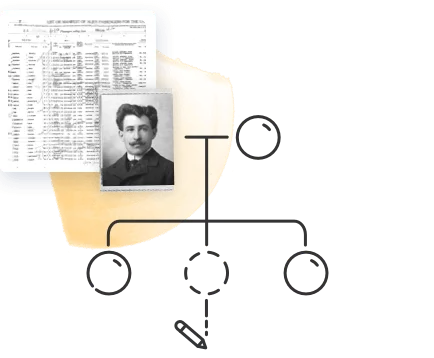
Tracing your family tree involves going back through the generations. It’s easy to start feeling overwhelmed, especially once you start expanding the branches of your family tree. Understanding generations and numbering systems can help streamline your genealogy research and keep it organized.
Whether you’re just starting your genealogy journey, or you want to organize your research, using a numbering system can make it easier to track and share your family tree. In this post, we’re sharing everything you need to know about generations and how to decide which numbering system is best suited for your genealogical research.
Key Takeaways:
- A generation is usually considered to be every 25-30 years, but it’s important to consider historical and cultural contexts.
- Numbering systems make it easier to keep track of the different generations in your family tree, including spotting potential mistakes and inaccuracies.
- The Ahnentafel system is the most common genealogical numbering system, offering a predictable numbering structure and making it easy to record your family tree in text format.
What Is a Generation in Genealogy?
A generation in genealogy refers to the average time between a parent’s birth and their child’s birth. In general, this is 25-30 years. Each generation represents a different step of your family tree, going from your parents to grandparents and great-grandparents.
However, it’s important to remember that this time span isn’t set in stone. Generations refer to the sequence of relationships, rather than a specific period. A generation may cover a longer time if the parents had children later in life or it might be shorter if they had children as teenagers.
Generations provide structure to your family tree, making it easier to understand how you’re related to different ancestors and their subsequent descendants.
Why Are Numbering Systems Used in Family Trees?
Understanding the generations of your family tree is the most important part of your genealogical research, ensuring its accuracy. Your family tree consists of different generations and a numbering system enables you to treat these generations like data. A numbering system makes it easier to avoid common research mistakes, especially if you have multiple family members with the same or similar names.
Once you begin exploring the different branches of your family tree, a genealogical numbering system provides crucial context, allowing you to understand your relationship to specific individuals. If you’re feeling overwhelmed by a large family tree with potentially hundreds of relatives, a numbering system can make it easier to document and navigate your ancestry.
A genealogical numbering system allows you to:
- Get an instant overview of your family tree with a simplified structure.
- Track naming traditions across different generations.
- Streamline your recording and documenting of your family tree.
- Identify how you’re related to a specific person in your ancestry.
- Cross-reference individuals against vital records, including census records.
- Collaborate with other genealogical researchers and relatives.
What Is the Ahnentafel System and How Does It Work?
The Ahnentafel system is the most popular type of genealogical numbering system and is easy to follow. It always starts by assigning the number 1 to yourself or the person whose ancestry you’re researching. This numbering system does not assign the next subsequent number to each generation. Instead, it assigns an odd number to the father and an even number to the mother.
For example, if you’re researching your own family tree, you would be number 1. Your father would be assigned number 2 and your mother would receive number 3. Your paternal grandfather and grandmother would be 4 and 5 respectively, while your maternal grandfather and grandmother are 6 and 7.
Pro-tip: Each person’s father is assigned a number that is double their number, while their mother is double their number plus one.
This binary pattern can take time to understand but it is popular with genealogical researchers due to its predictability.
The Ahnentafel system is beneficial as it:
- Offers a compact structure, making it easier to print or document your family tree to share with others.
- Is widely used throughout the genealogical community, particularly for research focusing solely on tracing ancestors instead of descendants.
- Allows you to document your family tree in a text format, instead of drawing a traditional family tree with multiple branches.
Which Numbering System Should I Use for My Family Genealogy Research?
Although the Ahnentafel system is commonly used, it’s not the only numbering system available for family genealogy research. Other popular numbering systems include:
- Register Style: Tracing the descendants of a single ancestor using Roman numerals with individuals numbered sequentially within each generation. Descendants who continue the family line are given an asterisk and their own entry. This system is best for published research and written family histories.
- National Genealogical Society Quarterly (NGSQ) Style: A scholarly variant of the register style, incorporating a narrative structure with clear citations. This numbering system is more formal and typically reserved for academic and peer-reviewed research.
- Henry System: Designed for reports and summaries, this numerical system takes a hierarchical view of descendants with the starting ancestor assigned the number 1. Each descendant’s number begins with their parent’s, meaning each number represents another step in the family tree. However, this system can quickly become difficult to read and track if you’re tracing multiple descendants.
Most genealogical research, especially if you’re researching your own family tree, will focus on tracing direct ancestors. The Ahnentafel system may take time to get used to, but it’s the most versatile numerical system and works for digital platforms like MyHeritage and for documenting your family tree in a text or written format.
What Common Mistakes Should I Avoid With Generational Numbering?
It’s easy to make mistakes when tracing your family tree, especially when even documents like census records can contain conflicting information.
One of the most common mistakes people make when researching their family tree is skipping a generation or confusing someone’s grandfather as being their father. If your family tree contains people in several generations with the same name, you might mistake two individuals as being the same person.
These common mistakes can result in errors in your generational numbering, resulting in incorrect relationship paths and misaligned timelines.
Individual Family Situations
Real-life situations often don’t fit neatly into numerical structures. It’s important to consider context as long generational gaps, adoptions, and remarriages can require extra attention when applying your chosen numerical system.
Adoptions can be traced through guardianship records with the individual’s numbering following the same structural rules, with either an asterisk or a note added next to their name.
It’s worth remembering that long gaps can exist between generations. While it’s more common today for people to have children later in life, it’s happened throughout history and can also be the result of fostering or adoption.
Blended Families and Step-Parents
Blended families, including foster and step-parents, can also result in errors. It’s important to link each child and their respective parent and use a consistent method for documenting relationships within blended families. If this occurs multiple times in your family tree, it may be easier to use a numerical system better suited for narrative documentation, such as the Register style.
Avoiding Common Generational Numbering Mistakes
Always double-check your information. You can use birth and death dates to provide generational consistency and cross-reference your information with church records, census records, and wills. Most people will have common names repeating throughout their family tree. Don’t assume a potential generational relationship from a name alone.
FAQs about Generations and Numbering Systems
How long is one generation in genealogy?
A generation is typically between 25-30 years, but it’s important to consider historical context and culture.
What does “Ahnentafel” mean?
Ahnentafel is the German word for ‘ancestor table’ and describes the numerical system used to describe your direct ancestors.
Can I use more than one type of numbering system for my family tree?
It’s best to use no more than two types of numbering systems to simplify your family tree. Most genealogists use the Ahnentafel system for ancestors and the Register or Henry system for descendants, primarily within different branches of your family tree.
Do I have to use a numbering system for my family tree?
It’s not a requirement to use any specific numbering system. At MyHeritage, your family tree will be automatically organized into different generations as you explore its various branches and uncover new connections. However, a numbering system can be helpful when sharing your genealogy research with your friends and family.
What is the difference between ancestors vs. descendants in my family tree?
Ancestors are the relatives who came before you, such as your parents and grandparents. By comparison, a descendant is someone who comes after you. Your research might include uncovering potential descendants of specific individuals in your family tree, such as your great-uncle’s children or other children of your great-grandparents.
Choosing the Right Numbering System for Your Family Tree
While it’s important to understand generations to ensure the accuracy of your family tree, you don’t have to use a specific numbering system. Consider the purpose of your genealogical research and how you want to share it with relatives, friends, and other potential collaborators. Using a numbering system, like the Ahnentafel system, can make your family tree easier to understand and contextualize.
Are you ready to start applying this knowledge to your genealogical research? Sign up for a free 14-day trial of MyHeritage and grow your family tree by exploring billions of historical records.



